The intended audience of this publication includes blackberry and pomegranate growers in Florida as well as Extension agents providing expert recommendations to both these industries. The purpose of this publication is to share information derived from a one-year field survey on commonly encountered pests.
Currently, blackberry and pomegranate (Figure 1) are growing in importance as alternative crops in Florida. In the past decade, blackberry production in Florida increased from 64 acres in 2007 to 173 acres in 2017 (USDA-NASS 2017). There are numerous health benefits acquired from these fruits, which makes them a good alternative option for growers in Florida to diversify their operations by planting some new and less traditional crops, providing them a niche in the Florida agriculture market.
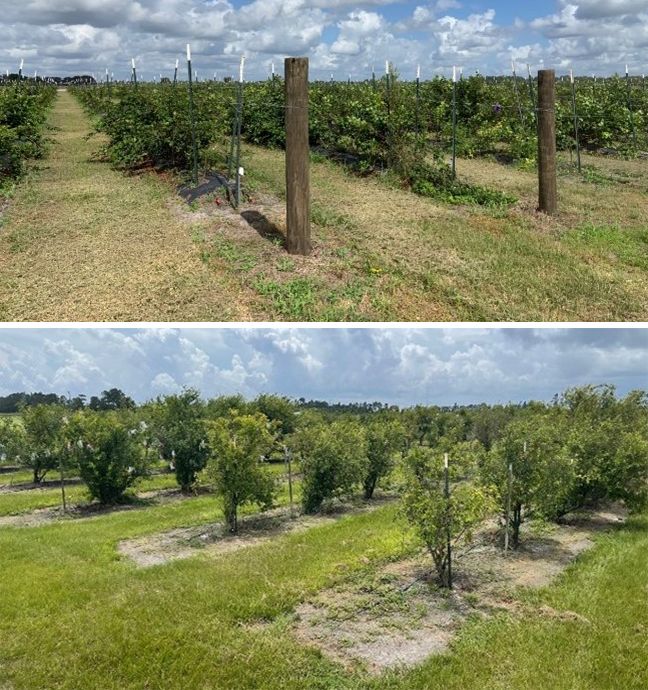
Credit: Chastity Perry, UF/IFAS
Since Florida has a suitable climate for many arthropod pests, the overarching concern for success of alternate perennial crops such as blackberry and pomegranate is pest management. The ability to recognize common pests, their feeding damage, and their natural enemies is key to determining the best control methods for each pest. Currently this information is lacking for blackberry and pomegranate production systems in Florida. Therefore, a biweekly survey (June 2020–September 2021) of blackberry and pomegranate orchards at UF/IFAS-GCREC was conducted using yellow sticky cards and visual observations. The common arthropod pests found in blackberry and pomegranate orchards as a result, are discussed here.
Blackberry Pests
Black-winged Sharpshooter
Sharpshooters are invasive leafhoppers in Florida. They have piercing-sucking mouthparts, which they use to feed on the xylem and phloem tissues of host plants. The black-winged sharpshooter, Oncometopia nigricans Walker (Hemiptera: Cicadellidae), is 8–9 mm long and yellow or orange with pronotum and bluish to bluish-gray forewings (Figure 2). Wings have black markings along veins. Sharpshooters go through incomplete metamorphosis with five nymphal instars and an adult stage. Female sharpshooters lay their eggs in masses under the epidermis of leaves. The nymphs are wingless and leap from leaf to leaf in search of food. Sharpshooters feed on a wide variety of plants and can cause physical damage to plants in large enough numbers, which most often occurs in spring and summer. However, the primary damage from sharpshooters comes from vectoring infectious pathogens that cause economically important diseases in plants. There is currently no documented evidence of this pest vectoring diseases of blackberries and pomegranates in Florida.

Credit: Chastity Perry, UF/IFAS
Management
Cultural Control
Prevention is the best cultural control. Once sharpshooters are established, there are no other cultural control measures that will work. Prevent the transport of infested plant materials into areas where infestations do not presently occur by inspecting all incoming plant materials or purchasing from certified growers.
Biological Control
Egg parasitoids in the genus Gonatocerus are important natural enemies of sharpshooters here in Florida (Tipping 2012). It is also important to avoid the use of broad-spectrum insecticides that affect natural predator populations such as lacewings, praying mantises, and assassin bugs.
Chemical Control
Chemical control options are not recommended in urban and suburban landscapes. See Table 1 for registered products for Florida blackberry.
Table 1. Registered products for Florida blackberry.
Flea Beetle
Flea beetles are small, metallic blue-green beetles with great jumping skills. The flea beetle, Altica spp. (Coleoptera: Chrysomelidae), varies in size from 3–9 mm. Females lay their eggs in clutches of 1–15 on the upper and lower surfaces of leaves. Larvae emerge after 5–8 days, are dark brown, and have 10 body segments (Phillips 2019). This species has three larval stages. Pupation occurs in the soil. Adults emerge from the soil in the spring. Larvae and adults both have biting-chewing mouthparts that they use to feed on foliage (Figures 3 and 4). Flea beetles are found worldwide and can cause damage to economically important plants if they reach large numbers, but they are also excellent biological control agents for weed management.
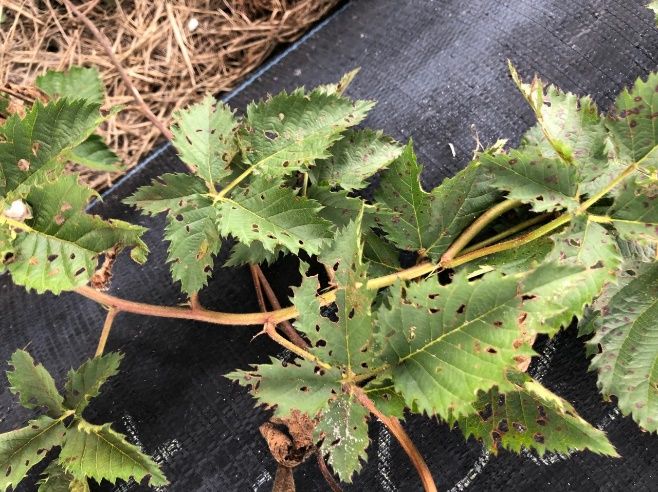
Credit: Chastity Perry, UF/IFAS
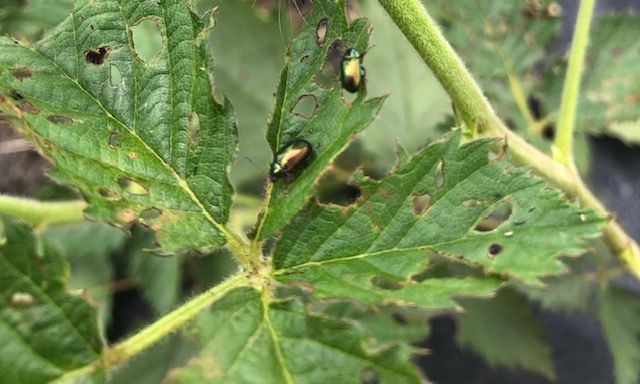
Credit: Chastity Perry, UF/IFAS
Management
Cultural Control
Remove potential weed hosts such as willowherb (Epilobium species) to help prevent establishment (Phillips 2019). Scouting in early spring is also helpful.
Biological Control
Parasitoids are also known to attack flea beetles. Hymenopterans from the family Braconidae and dipterans from the family Tachinidae are natural predators of flea beetles in Florida (Phillips 2019). Maintaining a healthy predator population will help keep flea beetles from establishing in large numbers.
Chemical Control
See Table 1 for registered products for Florida blackberry.
Citrus Root Weevil
The citrus root weevil, Diaprepes abbreviatus Linnaeus (Coleoptera: Curculionidae), is native to the Caribbean but was introduced to Florida in 1964 and is now found from central Florida to the southern portion of the state. The citrus root weevil is a known pest of citrus but is considered a generalist herbivore since it infests a number of different woody plants including blackberries and pomegranates (Weissling 2019). Adult weevils range in length from 9.5–19 mm. They are black with white, red-orange, or yellow scales on their wing covers (Figure 5). Females lay their oblong-oval shaped eggs in clusters by gluing them between two leaves. Once the eggs hatch, the larvae enter the soil and feed for several months before pupating. Adults emerge from the soil during the spring and summer months using deciduous mandibles that break off during emergence. Citrus root weevil larvae are the primary source of plant damage, due to their feeding on roots, which causes girdling to the taproot and prevents the plant from taking up water and nutrients. The damage usually kills the plant.
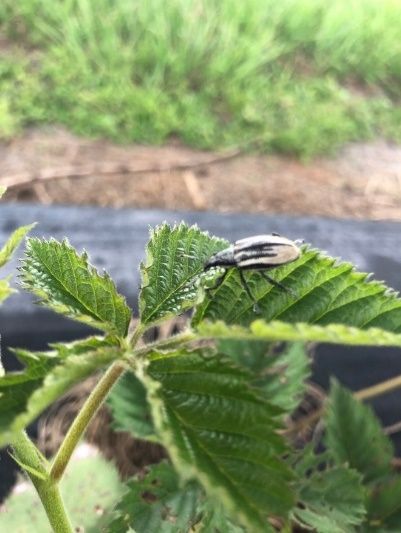
Credit: Chastity Perry, UF/IFAS
Management
Cultural Control
Hand picking and removing adult weevils, which is easier to accomplish at night, is one method to help reduce populations of weevils. Using different mulches, like metalized reflective mulch, can help prevent the larvae from entering the soil and the adults from emerging.
Biological Control
Entomopathogenic nematodes and fungi are both used to help control root weevil populations. Egg parasitoids established in Florida are known to prey on the eggs of root weevils. Aprostocetus vaquitarum Wolcott and Quadrastichus haitiensis Gahan (Hymenoptera: Eulophidae) both cause high parasitism rates in southern Florida (Weissling 2019).
Chemical Control
See Table 1 for registered products for Florida blackberry.
Raspberry Cane Borer
Raspberry cane borers have a wide distribution and are found all over the southeastern United States. The raspberry cane borer, Oberea bimaculata Oliver (Coleoptera: Cerambycidae), infects blackberry, raspberry, and dewberry. Adult cane borers emerge in late spring, range in size from 12–13 mm, and are black with a coppery-red or golden thorax or neck region. Females lay the eggs near the root or base of a leaf after piercing the cane in two rows, one above the egg laying site and one below it. Once the eggs hatch, the larvae begin eating sapwood and then bore into the pith where they overwinter for two seasons, eventually reaching ground level. The elongate larvae are pale yellow to white and range in length from 15–19 mm (Figure 6). The larvae cause damage from feeding on the canes, causing girdling and galls, which can harm or kill the plant. The adults emerge from the cane during the following spring. The damage caused by this insect begins when the female prepares to lay the eggs by making punctures around the cane (Figure 6). This causes the tip of the cane to wilt (Eaton 2016).
Management
Cultural Control
Regular pruning is usually enough to keep populations at a low level, and since the damage is so easy to spot, scouting for the wilted canes is suggested, especially in the months of June and July (Eaton 2016). Cutting girdled canes and burning them is another suggested practice if populations reach damaging levels.
Biological Control
Agents are not available, and chemical applications are not recommended for this pest.
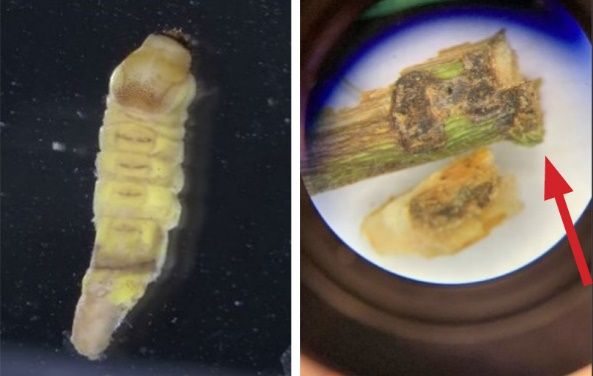
Credit: Chastity Perry, UF/IFAS
Dusky Stink Bug
Dusky stink bugs are found all over North America. Dusky stink bugs, Euschistus tristigmus Say (Hemiptera: Pentatomidae), are known pests of many different plant species and have a broad host range. Adults range in size from 9.5–13 mm in length with a shield-shaped body that ranges from 6–8 mm wide (Figure 7). Females deposit their eggs in masses on the undersides of leaves. Nymphs hatch and complete five nymphal instars before becoming adults. Dusky stink bugs cause damage to fruits by feeding during blooming and during shuck split, which leads to the fruit being aborted or covered in lesions. The severity of the damage depends on the population size but can be severe with large populations of stink bugs.
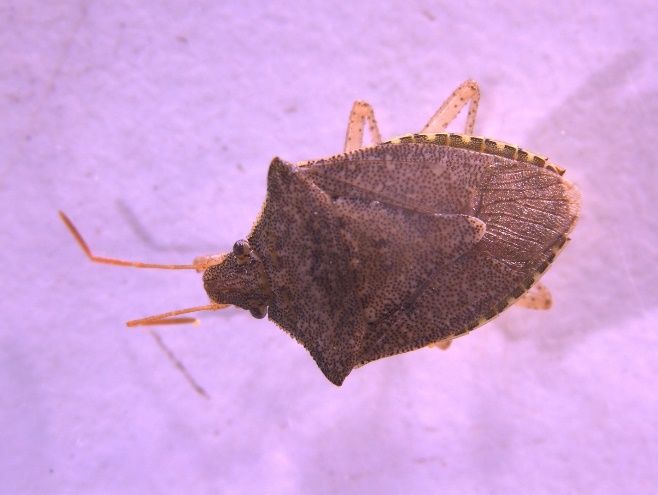
Credit: Chastity Perry, UF/IFAS
Management
Biological Control
Maintaining a natural predatory and parasitoid population is ideal to help control stink bug populations. Predators such as big-eyed bugs, grasshoppers, and spiders feed on stink bugs (Morrison 2016).
Chemical Control
See Table 1 for registered products for Florida blackberry.
Twospotted Spider Mite
The twospotted spider mite, Tetranychus urticae Koch (Acari: Tetranychidae), is a significant arthropod pest in multiple fruit crops. Adult twospotted spider mites range from 2–3 mm in length, have eight legs, and are tan or greenish with two dark spots, one on each side of the back (Figure 8). There are four developmental stages of the twospotted spider mite: egg, larva, two nymphal stages, and adult. Adult mites can overwinter on canes or in plant debris while waiting for warmer temperatures to significantly increase mite activity. Twospotted spider mites feed on the sap of leaves, causing chlorosis, which reduces plant vigor, leading to premature leaf drop. Webbing on the undersides of leaves is indicative of spider mite feeding. With high infestations, these pests can cause severe yield loss.
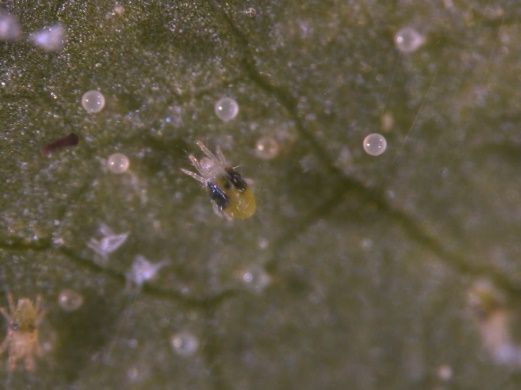
Credit: Chastity Perry, UF/IFAS
Management
Cultural Control
Scouting regularly for spider mites will help identify areas of infestation before the populations become overwhelming. Removing weed hosts such as wild geranium, pokeweed, and Jimson weed, may also help reduce spider mite populations (Fasulo 2009).
Biological Control
Predatory mites can be applied to plants (augmentative biological control) to reduce or eliminate spider mite populations. The predatory mite, Phytoseiulus persimilis Athias-Henriot (Acarina: Phytoseiidae) is commonly used in Florida; lady bird beetles (Coleoptera: Coccinellidae), lacewing larvae (Neuroptera: Chrysopidae), minute pirate bugs, Orius spp. (Hemiptera: Anthocoridae), and some thrips species (Thysanoptera: Thripidae) also prey on twospotted spider mites.
Chemical Control
See Table 1 for registered products for Florida blackberry.
Thrips
Several species of thrips (Thysanoptera: Thripidae), such as the Florida flower thrips, Frankliniella bispinosa Morgan, usually feed on flowers of blackberry in Florida but are not typically associated with fruit yield loss. However, western flower thrips, Frankliniella occidentalis Pergande can cause fruit yield losses. Chilli thrips, Scirtothrips dorsalis Hood have emerged as a common pest of many plant hosts in Florida. Thrips have a broad host range and are well known pests of many crops. Adult chilli thrips are a quarter of the size of western flower thrips (Figure 9). Western flower thrips adults are approximately 0.8 mm in length. Thrips go through complete metamorphosis, developing through five specific stages: egg, two larval stages, prepupa, pupa, and adult.
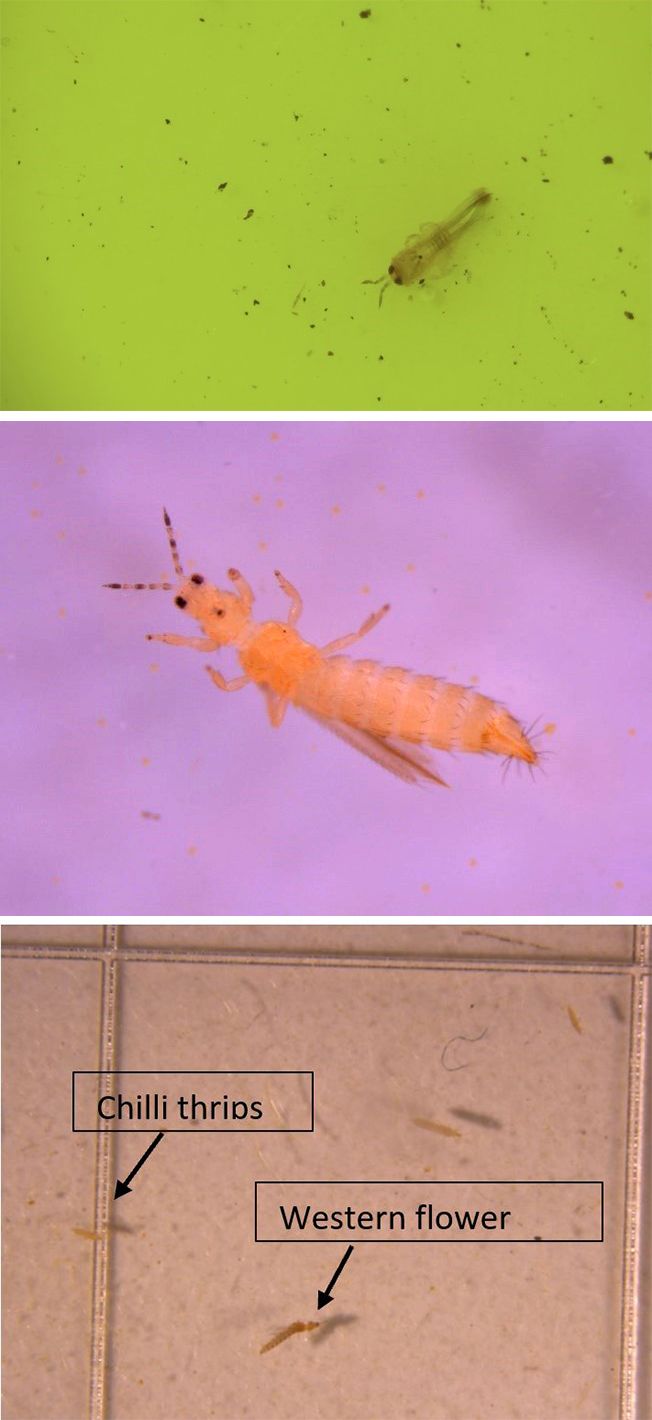
Credit: Chastity Perry, UF/IFAS
Management
Cultural Control
Scouting fields to detect chilli thrips and western flower thrips early in the season is essential.
Biological Control
Predatory mites are an effective control method for thrips. Phytoseiid mites, Neoseiulus cucumeris (Oudemans) and Amblyseius swirskii Athias-Henriot (Arachnida: Phytoseiidae) are commercially available predatory mites that primarily feed on first instar larvae of thrips (Mouden 2017).
Maintaining natural predator populations can also help reduce thrips populations.
Minute pirate bug, Orius spp. (Hemiptera: Anthocoridae), and bigeyed bug, Geocoris spp. (Hemiptera: Geocoridae) are natural predators of thrips. Both minute pirate bugs and bigeyed bugs feed on larvae and adult thrips (Kaur 2022).
Chemical Control
Thrips develop resistance to most insecticides rapidly. Therefore, rotating modes of action is very important. See Table 1 for registered products for Florida blackberry.
Leaffooted Bug
Leaffooted bugs are widespread and commonly found in Florida (Figure 10) but are considered a minor pest in most crops. Leaffooted bugs, Leptoglossus phyllopus Linnaeus (Hemiptera: Coreidae), are typically found in the spring and summer months in abundance. Adults range in size from 1.6 to 1.9 cm. They are brown with variations of orange on the abdomen. Females lay eggs in a single row along the stem or midrib of the leaf. Nymphs are shaped like the adults but lack the leaf-like hind tibia until adulthood. Leaffooted bugs feed on the receptacle between the drupelets of the fruit, causing damage near the insertion point and rendering the fruit unmarketable (Mead 2019) (Figure 10).

Credit: Chastity Perry, UF/IFAS
Management
Cultural Control
Scouting during summer is essential. Hand picking adult leaffooted bugs off plants can also help to reduce populations. Remove rotten or ripened fruits and destroy egg masses found on the leaves (leaffooted bug eggs are laid in a straight line) (Mead 2019).
Biological Control
Maintain a predator population including spiders, tachinid flies, assassin bugs, and amphibians and reptiles such as frogs and lizards (Mead 2019).
Chemical Control
Adult leaffooted bugs are not effectively controlled by chemical means. If leaffooted bugs are at population levels that require chemical control, the insecticide used needs to target the nymphs early in the season.
Pomegranate Pests
Southern Citrus Root Weevil
The southern citrus root weevil, Pachnaeus litus Germar (Coleoptera: Curculionidae), is native to Florida and is considered a minor pest with a broad host range. Damage severity is dependent upon population size. Adult southern root weevils range in length from 8.5–14 mm and are blue-green to aqua (Figure 11). Similar to the citrus root weevil, females lay their cylindrical eggs in clusters by gluing them between two leaves. Once the eggs hatch, the larvae enter the soil and feed on the roots for several months before pupating. Larvae cause damage to the roots, which can weaken trees by preventing water and nutrient uptake. Adults emerge from the soil from May through July (Weeks 2012).
Management
Management for southern citrus root weevil is similar to that of the citrus root weevil, Diaprepes abbreviatus Linnaeus (Coleoptera: Curculionidae).
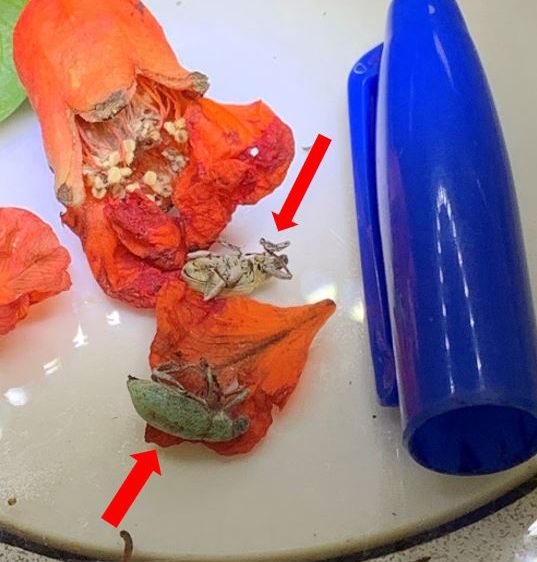
Credit: S. Lahiri, UF/IFAS
References
Agehara, S., S. Lin, and Z. Deng. 2019. “Choosing the Right Blackberry Cultivar in Subtropical Florida.” HS1352. EDIS 2019. https://edis.ifas.ufl.edu/publication/HS1352
Anderson, P. 2020. “The Blackberry.” HS807/HS104. EDIS 2020. https://edis.ifas.ufl.edu/hs104
Cluever, J., J. Funderburk, and H. Smith. 2018. “Western Flower Thrips (Frankliniella occidentalis [Pergande]).” ENY-883/IN1089. EDIS 2018. https://edis.ifas.ufl.edu/publication/IN1089
Eaton, A., and R. Maccini. 2016. “Raspberry Cane Borer” [fact sheet]. University of New Hampshire Cooperative Extension. https://extension.unh.edu/resource/raspberry-cane-borer-fact-sheet
Fasulo, T. R., and H. A. Denmark. 2003. “Twospotted Spider Mite, Tetranychus urticae Koch (Arachnida: Acari: Tetranychidae)” EENY150/IN307. EDIS 2003 (15). https://doi.org/10.32473/edis-in307-2000
Kaur, G., and S. Lahiri. 2022. “Chilli thrips, Scirtothrips dorsalis Hood (Thysanoptera: Thripidae) Management Practices for Florida Strawberry Crops.” ENY2076/IN1346. EDIS 2022 (1). https://doi.org/10.32473/edis-in1346-2022
Kakkar, G. 2017. “Common Blossom Thrips: Frankliniella schultzei Trybom (Insecta: Thysanoptera: Thripidae).” EENY-477/IN860. EDIS 2017. https://edis.ifas.ufl.edu/publication/IN860
Kumar, V., D. Seal, and G. Kakkar. 2021. “Chilli Thrips: Scirtothrips dorsalis Hood (Insecta: Thysanoptera: Thripidae).” EENY-463/IN833. EDIS 2021. https://edis.ifas.ufl.edu/publication/IN833
McWhirt, A. 2017. “What is going on with my blackberry fruit?” University of Arkansas. https://www.uaex.uada.edu/farm-ranch/crops-commercial-horticulture/horticulture/ar-fruit-veg-nut-update-blog/posts/fruitdisorders.aspx
Mead, F. 2019. “Leaffooted Bug: Leptoglossus phyllopus (Linnaeus) (Insecta: Hemiptera: Coreidae).” EENY-72/IN229. EDIS 2022. https://edis.ifas.ufl.edu/publication/IN229
Morrison, R. 2016. “Native predators may be having a larger impact than expected on invasive stink bug.” Entomology Today. https://entomologytoday.org/2016/03/25/native-predators-may-be-having-a-larger-impact-than-expected-on-invasive-stink-bug/
Mouden, S., K. Sarmiento, P. Klinkhamer, and K. Leiss. 2017. “Integrated Pest Management in Western Flower Thrips: Past, Present, and Future.” Pest Management Science 73 (5): 813–822. https://doi.org/10.1002/ps.4531
Phillips, E. and J. Gillett-Kaufman. 2019. “Flea Beetles of the Genus Altica: Altica spp. (Insecta: Coleoptera: Chrysomelidae).” EENY-721/IN1238. EDIS 2019 (2). https://doi.org/10.32473/edis-in1238-2019
Sarkhosh, A. and J. Williamson. 2018. “The Pomegranate.” HS-44/MG056. EDIS 2019 (1). https://doi.org/10.32473/edis-mg056-2019
Sprague, D., J. Funderburk, and A. Lucky. 2018. “Flower Thrips: Frankliniella tritici (Fitch) (Insecta: Thysanoptera: Thripidae).” EENY-720/IN1236. EDIS 2019. https://doi.org/10.32473/edis-in1236-2019
Tipping, C. and R. Mizell, III. 2012. “Sharpshooters, Leafhoppers, Cicadellidae (Insecta: Hemiptera: Auchenorrhyncha: Cicadellidae).” EENY-334/IN611. EDIS 2020. https://doi.org/10.32473/edis-in611-2004
U.S. Department of Agriculture. 2017. “USDA/NASS Quickstats Ad-Hoc Query Tool.” 8 July 2019. https://quickstats.nass.usda.gov/results/4108C49E-88A5-396A-B5DB-DD69F427E44A
Weeks, J., A. Hodges, and N. Leppla. 2012. “Citrus Pests, Southern Citrus Root Weevil.” https://idtools.org/citrus_pests/index.cfm?packageID=63&entityID=411
Weissling, T, J. Pena, R. Giblin-Davis, and J. Knapp, Jr. 2022. “Diaprepes root weevil: Diaprepes abbreviatus (Linnaeus) (Insecta: Coleoptera: Curculionidae).” EENY-24/IN151. EDIS 2022. https://edis.ifas.ufl.edu/publication/IN151